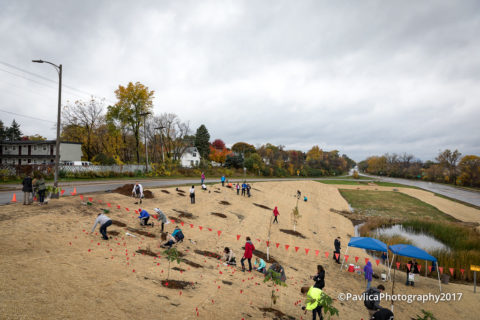Meet 2017 Steward Steve Mitrione
In spring 2019 Nat Kolasa-Lenarz, a service-learning student from the University of Minnesota spent time interviewing three of Capitol Region Watershed District’s Minnesota Water Stewards (formerly Master Water Stewards). We’ll be sharing the interviews to highlight the work of these community leaders, and to encourage others to consider becoming a Minnesota Water Steward.
 Steve Mitrione is a 2017 Minnesota Water Steward (MWS) and active watershed volunteer. Steve’s capstone project includes plans for two 600 square-foot rain gardens at the corner of Pierce Butler Route and Albert Street in Saint Paul. The rain gardens will be next to the Midway Green Spirit Community Garden. The site has overlapping government agencies, the community garden land is owned by the City of Saint Paul while Ramsey County manages Pierce Butler. This added complexity to the project and took longer to complete than the average capstone project, but the rain gardens are scheduled for construction this fall. Capitol Region Watershed District (CRWD) contributed funding for the gardens and assisted in the development of the design with Ramsey Conversation District. In addition to the capstone project, Steve assists in various CRWD community projects, including the 2017 Pierce Butler Meadows planting event with Plantón Móvil, a mobilization of living plants.
Steve Mitrione is a 2017 Minnesota Water Steward (MWS) and active watershed volunteer. Steve’s capstone project includes plans for two 600 square-foot rain gardens at the corner of Pierce Butler Route and Albert Street in Saint Paul. The rain gardens will be next to the Midway Green Spirit Community Garden. The site has overlapping government agencies, the community garden land is owned by the City of Saint Paul while Ramsey County manages Pierce Butler. This added complexity to the project and took longer to complete than the average capstone project, but the rain gardens are scheduled for construction this fall. Capitol Region Watershed District (CRWD) contributed funding for the gardens and assisted in the development of the design with Ramsey Conversation District. In addition to the capstone project, Steve assists in various CRWD community projects, including the 2017 Pierce Butler Meadows planting event with Plantón Móvil, a mobilization of living plants.
The following is an excerpt from an interview by Nat from March 2019
How long have you been a Minnesota Water Steward?
Steve: Going on three years now. The interesting thing is that I started this process about 3 years ago, but I have yet to complete my capstone project. Hopefully it will be completed this June, which will officially conclude my certification process. Update: The rain garden construction has been moved to the fall of 2019.
What is your prospective capstone project?
Steve: I’m working on developing a rain garden over on Pierce Butler in Saint Paul. It will be associated with the [Hamline Midway Green Spirit] Community Garden that already exists there.
That’s great! What first inspired you to seek certification?
Steve: *laughter* Well, I’ve known Lindsay Schwantes (CRWD Community Outreach Coordinator) for many years and she said several times I should be a Water Steward. I had already done a rain garden project with CRWD 7-8 years ago in front of my house.
What surprised you about the program?
There’s a messaging component to the training that I didn’t anticipate, and it was something new to me. Through that education we learned how to carry our message and mission to the general public. It was, in my view, training on how to present the concepts we were learning to a wider audience and how to get buy-in from people on our mission and goals.
If you were to talk to someone considering the program, what would you share with them?
I think the commitment itself isn’t overwhelming. It can be done in short intervals over a long period of time. You get to meet some great people and there’s a lot of good talent – people who are very passionate about conservation. It’s just a fantastic group of people. We’ve had several events that straddle the line of social and professional (in terms of MWS work) and those have always been great.
How many hours per week/month did you spend on MWS work during certification? Now?
Well, if I’m honest, my work schedule caused a fair bit of conflict with the course schedule. But I still managed to learn the material thanks to the help of those who lead the program. Even so, I spent several hours a month on it.
What was your greatest challenge along the way? How did you approach this challenge and what was the outcome?
Probably trying to get my project developed. I was working with CRWD, Ramsey County, and [the City of] Saint Paul. Working with those different government agencies (and getting them all on the same page) is the definition of “complicated” to the power of three. It required a lot of contacts to keep progress moving forward, but persistence always pays off. In my experience, resilience and persistence with others is essential to the success of a project within the public realm.
So, a bigger payoff, but more work required?
Yeah, persistence is key. You must get comfortable with being what some people may see as “a pain in the butt.” As far as I’m concerned, it’s really a matter of holding people accountable for the things they agree to.
How have you handled your commitment to inspire your community to engage in water quality practices and projects?
Well, from the community perspective, it hasn’t been all that difficult to convince people to buy in to the concept. Let’s put it this way: I really believe the public gets it because they’re the ones who are seeing the results firsthand.
A community that’s involved is an incredibly valuable resource. What if you could have that community, every person, engage in one single water quality practice of your choosing? What would it be?
I believe demonstration is incredibly important. Projects that show the people in a community the direct results of an effort such as a rain garden or street cleanliness. Once people can physically see the mechanism in action, they tend to say “Oh! That’s what a rain garden is!” or “Wow! A bit of drain cleanup really makes things look better!” And then they get to reap and observe the long-term benefits to water quality. It’s absolutely a matter of “seeing is believing.”
That’s a great perspective. Thank you so much for taking the time out of your day to spread this message.
Read an interview with 2018 Master Water Steward Anthony Swichtenberg
Ready to make a difference in water quality?
Stewardship Grants help homeowners, businesses, schools and community organizations install water quality improvement practices like rain gardens, shoreline restoration, and water reuse systems. Learn more about CRWD’s Stewardship Grant Program.
What is a Minnesota Water Steward?
Minnesota Water Stewards is a program that certifies and supports community leaders to prevent water pollution and educate community members to conserve and protect our waterways. The program is a partnership between Freshwater and participating organizations. Learn more at minnesotawaterstewards.org/
How does the program work?
The certification process comprises of both online and in-person classes covering a wide variety of topics including hydrology, water policy, community engagement, and residential stormwater planning. Classes run from mid-October to mid-April each year, with approximately six in person classes over the course of seven months.
Steward candidates are sponsored by their local water management organization or municipality and attend classes with a cohort of other candidates in their region.
Become a Minnesota Water Steward!
Interested in becoming a Minnesota Water Steward?
- The application period has closed.
- Visit minnesotawaterstewards.org/ or call us at (651) 644-8888 to learn more.
